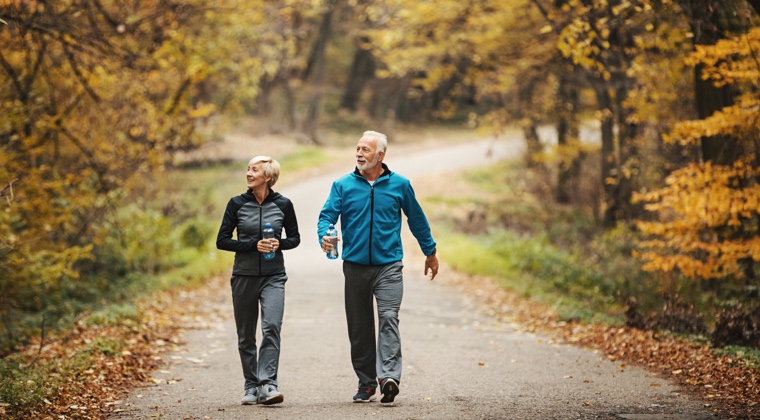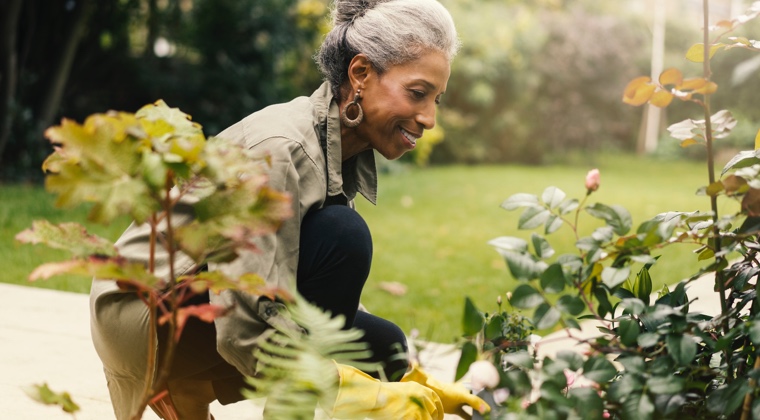Activity and Exercise
Exercise
You may think that you have too much pain to exercise. You might not know how to exercise with your limitations. Or you may worry that being more active might make you feel worse. These are all valid concerns, but being more active may eventually have the opposite effect. In the long-run, regular physical activity will help you manage your pain.
Benefits of regular exercise include:
- Helping you sleep better
- Reducing your pain and fatigue
- Improving your cognitive function (thinking ability)
- Better balance and mobility
- Better mood
What are some reasonable exercise goals for people living with pain?
Guidelines from the American College of Sports and Medicine (ACSM) say that adults should aim to get:
- at least 150 minutes of moderate-intensity exercise per week.
This ACSM recommendation is the most widely recommended goal, even for people with chronic illnesses and chronic pain. If this amount seems overwhelming to you, the good news is that a little bit of physical activity - even 10 minutes a day - can make a difference. The key is to start slowly and with activities that are easy for you to do. Over time, you can gradually increase your activity and start to do more. Be sure to talk with your healthcare provider first before you change or increase the amount of activity that you do. This can help you make sure that your symptoms are under control and that it is safe to start. It can also help you avoid overexerting yourself, which can lead to a flare-up, or worsening, of your symptoms.
Exercise intensity TIP: What do you mean by “moderate intensity?”
You can tell when you are engaging in moderate intensity exercise if the exercise:
- Makes you breathe quicker, but you are not out of breath
- You break a light sweat after about 10 minutes
- You can carry on a conversation, but don’t have enough breath to sing
Myths and facts about physical activity and chronic pain
MYTH:
People with pain should not and cannot be physically active.
FACT:
Studies have shown that people with pain benefit from being active. In fact, exercise is a key part of managing pain. Exercise is related to more energy, less pain, and better mood.
MYTH:
You will feel worse if you are more active.
FACT:
Over time, being active may help improve your mood and physical function, although you may feel more pain or fatigue at first.
Your muscles may have become deconditioned, or weaker, due to inactivity, but this may lessen as your body adjusts to being active again. Remember that over-exercising can also lead to more pain or fatigue. Talk with your healthcare provider about ways to help you be more active.
Exercises for people with pain
There are 4 types of structured exercise that have been shown to help people with pain. Keep in mind that these activities can be done at a gym, at home, or in your community.
Aerobic exercise
- ACSM recommendations: Adults should get at least 150 minutes of moderate-intensity exercise per week.
- Includes walking, water aerobics, and stationary cycling
- Helps improve your circulation and strengthen your heart. Because it stimulates your cardiovascular system, this may help reduce fatigue if your muscles have become deconditioned.
- It is best to gradually increase the amount of time you do aerobic exercise. For some people, this may mean slowly working up to 30 minutes per day, most days of the week.
- People who cannot do the recommended minimum can still benefit from some activity; 10 minutes of activity is better than none!
Flexibility, or stretching
- ACSM recommendations: Adults should do flexibility exercise at least 2-3 days per week to improve range of motion.
- Hold each stretch for at least 10-30 seconds to the point of tightness. Repeat each stretch 2-4 times.
- Stretching may provide pain relief and make tight muscles more flexible
- Flexibility is important for good posture, strength, and balance
- Do not bounce while stretching or stretch to the point of pain
- Stretching is most effective when muscles are warm. So, try flexibility exercises after aerobic activity.
Resistance or Strength training
- ACSM recommendations: Adults should do resistance training on each major muscle group (both upper body and lower body) 2-3 days per week.
- Very light strength training is best for older adults or those who are just starting to exercise.
- Includes weight lifting, sit-ups, resistance bands or tubes, and body-weight exercises (e.g. squats)
- Helps your muscles become stronger
- It may help you function better and take part in more activities
- It could counter muscle loss, and it may even result in muscle gain
- Focus on strengthening and toning, and not on body building or “bulking up”
Neuromotor Exercises
- ACSM recommendations: 20-30 minutes per day
- Sometimes called “functional fitness training”
- Can include various motor skills, such as coordination, gait, agility, and balance
- Examples of neuromotor exercises are yoga and tai chi.
Exercise tips
- Start at a low level and slowly work up to moderate activities as you are able
- On bad days, exercise as planned, but consider doing it at a lighter level or for less time
- Talk with your healthcare provider before starting or changing your exercise program
- Hydrate before and after exercise
What if I am just not ready to begin exercising right now?
Maybe you have been sedentary for so long that you can’t imagine beginning to exercise. Or, maybe you are afraid that even the slightest bit of exercise will cause a spike in your symptoms. Whatever your reason for being hesitant about starting to exercise right now, you might start by increasing your level of “lifestyle physical activity” first.
Lifestyle physical activities are things that you do or enjoy as a normal part of daily life, such as cleaning the house or playing with children. The important thing is to try to be active, and to give yourself credit for what you may be doing already. As you become more active, you can try to work up to more challenging activities gradually. Any increases in exercise intensity should occur gradually.
As you move from left to right across the activity spectrum below, you will see that the activities listed require more energy and physical effort. Depending on how you feel, it might be realistic for you to build up to activities in the mild and moderate ranges. Using the lists below as a general – but not complete – guide to the types of activities you can chose from in each category. As you become more active, you can try to work up to more challenging activities gradually.
| Examples of Physical Activities | |||
|---|---|---|---|
| Least intense | Most intense | ||
|
|
|
|
Scheduling tips
Whether you want to increase your lifestyle activities or start a structured exercise program, you may have trouble starting and sticking with a plan. It may help if you:
- Talk with your healthcare provider about starting or changing your exercise program
- Think about ways you can change less active times into more active ones. Use the Activity and Exercise Work Sheet to help you do this
- Pick a set time each day to be active and put it on your schedule. This will help you commit to it
- Plan to be active at times of the day when you feel your best or think it may help you the most. For example, it might be helpful to stretch in the morning if you feel stiff
- Start by scheduling small amounts of activity so you don’t overdo it
- Find a friend or family member to join you
Being active on a regular basis is a challenge for many people. It can be a special challenge for people living with pain. Becoming more aware of your challenges may help you move past them.
If you are afraid that being more active will cause a flare-up, then:
- Consider whether you may have done too much too soon in the past
- Plan ahead and pace yourself, using the tips in PainGuide’s Pacing section to find the right activity level for you
- Try thinking about being active as a way to help you feel better
If you are not sure about what to do or how to start, then:
- Think about your past and present activities
- Pick one thing to do and start slowly
- Keep track of what you do, how long you do it, and how you feel before, during, and after it
- Look at ideas available through organizations related to your specific condition
- Talk to your healthcare provider about options, including physical therapy
Don’t forget that everyone with pain has different abilities. Every day may be different. Just do what you can each day and build from there.
Some things to consider if you struggle with balance
- If you struggle with balance and are prone to falling, you need to be especially careful about your personal safety.
- Avoid slippery floors, poor lighting, throw rugs, and other tripping hazards
- Place a chair or other stable piece of furniture nearby to steady yourself if needed while you exercise
- Choose exercises that present less risk of falling, such as a stationary bike or water exercises.
- Remember your balance may improve that the stronger you get through regular exercise
A note about too much sitting
A note for family and friends
You can help with exercise
Many people who live with pain are not active. They may not know what to do, what they can do, or how to start. Here are some tips that may help people become more active:
- Help identify activities they enjoy
- Encourage them to track their progress, for example using PainGuide’s symptom monitoring features of downloadable work sheets
- Let them know that you would like to help them deal with concerns
- Help them create a good balance between rest and activity, using the PainGuide Pacing tips
- Being physically active and exercising is important to everyone’s health – including yours! In addition to encouraging your family and friends to exercise, be sure to take care of your own health. You may be able to find physical activities that you enjoy together, such as taking walks or doing stretching or yoga together.



